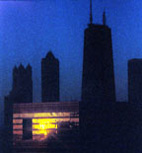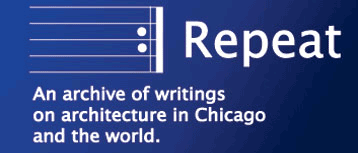

  |
||||
|
|
A James Turrell Skyspace Comes to a Very Different Maxwell Street -by Lynn Becker The University of Illinois at Chicago refabricates the neighborhood formerly known as Maxwell Street as a new and very different urban reality.
|
|
||
|
Last Friday saw the dedication of James Turrell's UIC Skyspace, a round, 43 feet in diameter observatory-type pavilion whose 26-foot-high ceiling is pierced by a central oculus designed tof create the experience of "celestial vaulting - the illusion, when viewing the sky without a horizon line, that the sky is aligned with the plane of the ceiling." Skyspace is the focal point for the Earl L. Neal Plaza, dedicated to the late lawyer, civic leader, and University of Illinois trustee who championed the construction of the school's west side campus in 1960's. The plaza is defined as providing a new gateway to the UIC South campus.
Turrell, who was on hand for Friday's ceremonies, is quoted as saying the UIC Skyspace "deals with light itself, not as "I want to create something that directly connects you to a thought that is wordless, a thought that doesn't have a story line," Turrell is quoted as saying.. "It's an arena of thought that has a kind of loneliness, but also a great beauty." How well this concept works out in practice at the heavily trafficked intersection of Halsted and Roosevelt remains to be seen. Although Turrell has a number of similar installations throughout the world, the one at UIC is described as the first directly accessible from public streets. Turrell's design include trees, a fountain, and, in warmer weather, "curtains of water . . . to soften the sight and sound of traffic and pedestrian activity" The UIC Skyspace is at the crossroads of a boom town of new development, dominated by the massive Ivy Hall residential project just across the street, where no fewer than 700 upscale units are rising on land cleared by the University as part of its massive redevelopment of what was previously Chicago's storied Maxwell Street district, for over a century a rough and tumble retailing district of discount shops and open air markets that catered to Chicago's poor immigrants, from Jews escaping Czarist Russia to blacks escaping the American south.
"It's quite something to make art in such an urban environment. This is a pretty tough corner, and this was a tough area when I first came here," recalled Turrell on Friday. “I have to say that the most remarkable thing for me is to see transformation that has happened to this area that the University has brought about, and to be apart of this, I'm proud. Four years ago, this was a very different area, just four years ago. ” In that short space of time, UIC has basically wiped out one cityscape for a very gentrified alternative. At the same time as Friday's cermoney, a wedding was taking place at the St. Francis of Assisi church right next door, an alternative world that seemed to exist in a different universe from that of the unversity-types attending Skyspace's dedication.
To sentimentalize poverty is a luxury of those who don't have to live in it. You can be sure that the former residents of Maxwell Street would have signed off of its destruction in a second if they could have moved to one of the spotless new condo's and townhouses of Ivy Hall. But, of course, they never had that choice. Redevelopment is a process, not of an upward integration, but of displacement. Those with power and money take what they want. Neighborhoods become safe again, the tax rolls swell,the city is renewed. Those without power pull up stakes and find some new area derelict enough to be affordable. Don't blame UIC. It's always been so. Maxwell Street is preserved in a single block, just off of Halsted that manages to be both beautiful and eerily creepy at the same time. The vintage buildings have been lovingly restored, the brick scrubbed, the terra cotta ornament shiny and perfect, far beyond what they probably ever looked like in their previous life. The occupants - some spaces remain empty - are no longer the kind of discounters that made the street famous, but upscale bars and fitness centers. It's all so perfect, it seems unreal, a Disneyland attraction landed like an alien spacecraft into the midst of an affluent cityspace.
The restored block is terminated at the end by a new parking garage, the street passing under a concrete arch inscribed with the name Maxwell Street. It's a gateway to nowhere. Tucked away on the other side are two polish sausage stands - the last survivors of the street as it was - and the edge-of-the earth frontier of the elevated Dan Ryan Expressway.
Join a discussion on this story. © Copyright 2006 Lynn Becker All rights reserved.
|
||||